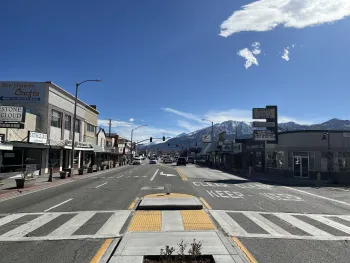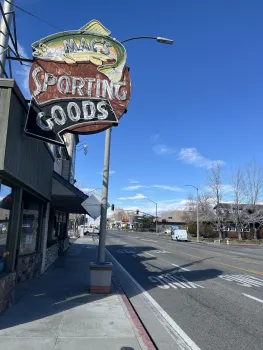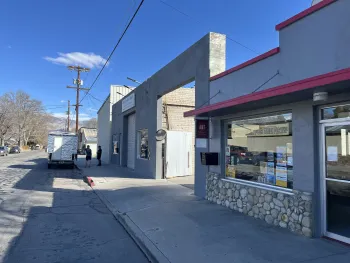Revitalizing Rural Main Streets: Lessons for the Eastern Sierra Part 3 of 3
Part 3 of 3: From Ideas to Action: How Might We Start?
This blog explores critical issues relevant to the community and economy of the Eastern Sierra and beyond. In the coming months, I’ll continue sharing short articles that feature case studies, emerging trends, and conversations with experts in the field.
To stay connected, subscribe to this blog and the Eastern Sierra Community and Economy Newsletter.
This is the final post in a three-part series on downtown revitalization in rural communities. In previous posts, I explored why revitalization efforts matter, what’s already happening in the Eastern Sierra, and key lessons from national research and case examples.
In Part 1, we looked at the importance of local context and community buy-in. In Part 2, we examined successful strategies—from downtown associations to entrepreneurship training—that help rural communities transform their Main Streets.

This final post offers actionable ideas for moving from conversation to coordination. It draws from the lessons of the first two posts, as well as local interviews and planning examples from California and nationally. So, what might a civic organization, a Chamber of Commerce, or some other group in the Eastern Sierra do to start and advance a conversation on revitalization?
1. Form a small ad-hoc working group.
Start with an informal team that includes members from civic groups, the Chamber of Commerce, planning departments, elected officials, and local businesses. This group can revisit past plans, set early priorities, and consider what a more formal effort might look like. Eventually, it could evolve into a downtown association or revitalization steering committee. The key early questions: What’s the purpose of this group? What’s the agenda? What goals can we start to define?
2. Engage with community leaders from other downtown programs.
Host listening sessions with leaders from other rural communities in California or from gateway towns across the country that have worked on Main Street revitalization. Ask what worked, what didn’t, and how they navigated community engagement, funding, and regulation. Towns like Hanford, Hollister, Eureka, Paso Robles, Lakeport, and San Juan Bautista are good California examples—many of which have used the Main Street framework. Out-of-state examples from Arkansas, Montana, Oregon, and Missouri were also highlighted in expert interviews. Our Extension networks can help make these connections.

3. Build relationships with Main Street technical assistance programs.
Leverage the support offered by California Main Street and Main Street America. As discussed in Part 2, these programs offer tested frameworks, technical support, and national peer networks. California Main Street leaders and affiliated associations have expressed interest in supporting exploration in the Eastern Sierra and could help connect us with state and national partners.
4. Reengage existing plans, revisit priorities, and surface new ideas—especially around what we’re good at.
At some point, discussion must shift into planning and early visioning. Successful revitalization efforts start with a locally driven sense of identity. Uniqueness matters—especially when people of means can choose where to visit or live. Ask: What makes our Main Street special? What do locals want? What would improve the visitor experience? Start assembling and reviewing available data on business activity and visitor traffic. What’s working? What’s missing? Begin community outreach, even if a formal process will come later.
5. Integrate the new Business Resource Center into revitalization efforts.
The research was clear: formal support for both existing businesses and new entrepreneurs is crucial for Main Street revitalization. Several case examples had programs that intentionally linked entrepreneurship programming with revitalization—using site selection and targeted recruitment to place promising startups on Main Street, while aligning efforts with community planning and vision.
6. Integrate equitable economic development practices that make sense for the Eastern Sierra.
The needs assessment I conducted last year pointed to real gaps: Latino communities are underrepresented in public processes and program development, and tribal partners have often not been included. Our Sierra Jobs First initiative has prioritized addressing these challenges. The interviews and literature review I did for these blogs reinforced these ideas. Outreach and building trust take time, but it matters. Consider language access, representation in working groups, and targeted business support to expand participation.

7. Celebrate small wins. This kind of work takes time.
In a past episode of the Reimagine Rural podcast, Tony Pipa of the Brookings Institution noted that many rural communities need years to build the capacity to manage major federal funding and to successfully implement multi-year projects. The same is true for Main Streets. The communities featured in the case studies I reviewed—Emporia, Oceanside, Wythville—made meaningful progress through decades of consistent vision, leadership, and small victories that added up over time. Revitalization happens through steady effort and momentum.
These blogs came out of a request from a community partner to explore potential solutions. What we found reached far beyond a simple toolkit or set of policy prescriptions. Revitalization frameworks and technical assistance matter—but at the end of the day, it’s about consistent engagement over time. The process is bound to be a little messy, full of trial and error, and entirely worth it. Thanks for reading.
